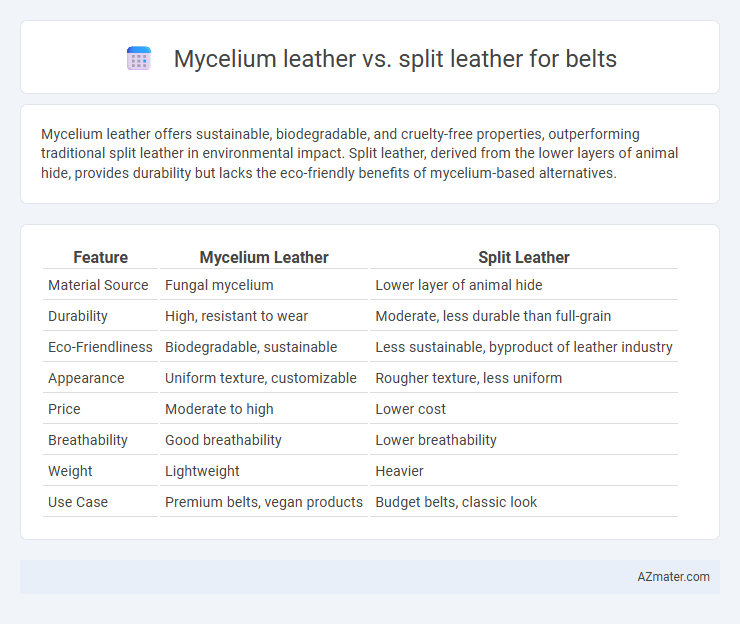Mycelium leather offers sustainable, biodegradable, and cruelty-free properties, outperforming traditional split leather in environmental impact. Split leather, derived from the lower layers of animal hide, provides durability but lacks the eco-friendly benefits of mycelium-based alternatives.
Table of Comparison
| Feature | Mycelium Leather | Split Leather |
|---|---|---|
| Material Source | Fungal mycelium | Lower layer of animal hide |
| Durability | High, resistant to wear | Moderate, less durable than full-grain |
| Eco-Friendliness | Biodegradable, sustainable | Less sustainable, byproduct of leather industry |
| Appearance | Uniform texture, customizable | Rougher texture, less uniform |
| Price | Moderate to high | Lower cost |
| Breathability | Good breathability | Lower breathability |
| Weight | Lightweight | Heavier |
| Use Case | Premium belts, vegan products | Budget belts, classic look |
Introduction to Mycelium Leather and Split Leather
Mycelium leather, made from the root structure of fungi, offers a sustainable and eco-friendly alternative to traditional animal-derived materials. Split leather, a byproduct of the tanning process, is created from the fibrous underside of a hide and is typically less durable than full-grain leather. Both materials present unique textures and environmental impacts that influence their suitability for belt production.
What is Mycelium Leather?
Mycelium leather is an innovative, sustainable material derived from the root structure of mushrooms, offering a biodegradable and eco-friendly alternative to traditional animal leather. Its natural fiber network mimics the texture and durability of leather while significantly reducing environmental impact compared to split leather, which is made from the lower layers of animal hides leftover from full-grain leather production. Mycelium leather's renewable sourcing and adaptability make it an increasingly popular choice for belts and other fashion accessories seeking sustainable and cruelty-free materials.
Understanding Split Leather
Split leather, derived from the fibrous layers beneath the top grain of animal hides, offers a more affordable and versatile option for belts, though it lacks the durability and natural texture of top grain or full grain leathers. Mycelium leather, made from mushroom roots, presents an eco-friendly alternative with a unique texture and enhanced sustainability, but may not yet match the long-term strength of traditional split leather. Understanding the composition and performance characteristics of split leather is crucial for choosing the right belt material based on durability, appearance, and environmental impact.
Sustainability: Mycelium vs Split Leather
Mycelium leather offers superior sustainability compared to split leather, as it is produced from fungal mycelium, a rapidly renewable resource that requires minimal water, land, and chemicals. Split leather, derived from the lower layers of animal hides, involves significant environmental impact due to livestock farming and tanning processes that generate greenhouse gases and toxic waste. Choosing mycelium leather for belts reduces carbon footprint and supports eco-friendly fashion by avoiding animal exploitation and chemical pollution.
Durability and Longevity Comparison
Mycelium leather offers impressive durability due to its dense, fibrous structure that resists cracking and wear over time, making it a sustainable alternative to traditional materials. Split leather, derived from the lower layers of the hide, tends to be less durable and more prone to stretching and tearing, especially under frequent use. For belt longevity, mycelium leather outperforms split leather by maintaining structural integrity and aesthetic appeal longer, reducing the need for frequent replacements.
Aesthetic Qualities and Texture Differences
Mycelium leather exhibits a distinctive, often smoother surface with organic, fibrous textures that create a modern and sustainable appeal, contrasting sharply with split leather's coarser, rougher texture that results from separating the fibrous layers beneath the top grain. The aesthetic quality of mycelium leather leans towards contemporary, eco-friendly vibes with consistent patterns, while split leather retains a rugged, natural look often prized for its durability and rustic charm. Texture-wise, mycelium provides a more uniform feel with slight pliability, whereas split leather offers a denser, stiffer touch that influences the belt's overall rigidity and wear resistance.
Comfort and Wearability for Belts
Mycelium leather offers superior comfort for belts due to its natural breathability and flexibility, reducing skin irritation and enhancing wearability over long periods. Split leather, derived from the fibrous part of the hide, tends to be less breathable and often requires additional treatments that can compromise softness and flexibility. For belts, mycelium leather adapts better to body movements and moisture, providing a more comfortable and durable option compared to the often stiffer and less breathable split leather.
Production Processes and Environmental Impact
Mycelium leather is crafted through a bio-fabrication process using fungal mycelium, which requires significantly less water and energy compared to the traditional tanning of split leather derived from animal hides. The production of split leather involves chemical-intensive treatments and emits pollutants, contributing to higher environmental degradation and carbon footprint. Consequently, mycelium leather offers a sustainable alternative for belts by reducing resource consumption and minimizing toxic waste in manufacturing.
Pricing and Market Availability
Mycelium leather typically commands a higher price point due to its sustainable, innovative production process and limited market availability compared to split leather, which is widely accessible and more affordable due to mass production. Split leather belts often dominate the market with lower costs ranging from $10 to $30, while mycelium leather belts can range from $50 to over $150, reflecting their eco-friendly value proposition. The growing demand for vegan and sustainable fashion is steadily increasing the presence of mycelium leather, though split leather remains the more prevalent choice for budget-conscious consumers.
Which Leather is Best for Belts?
Mycelium leather offers a sustainable, eco-friendly alternative to traditional split leather, featuring durability and a unique texture ideal for belts. Split leather, derived from the lower layers of cowhide, tends to be less durable and more prone to wear, making it less suitable for long-lasting belt use. When choosing the best leather for belts, mycelium leather stands out for its strength, environmental benefits, and resistance to cracking compared to conventional split leather.

Infographic: Mycelium leather vs Split leather for Belt
 azmater.com
azmater.com